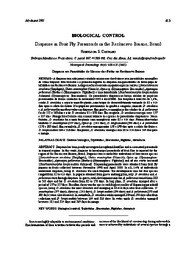Diapause in Fruit Fly Parasitoids in the Recôncavo Baiano, Brazil.
Diapause in Fruit Fly Parasitoids in the Recôncavo Baiano, Brazil.
Author(s): CARVALHO, R. da S.
Summary: ABSTRACT Diapause has been poorly investigated in tephritid fruit flies and in associated parasitoids in tropical regions. In this work, diapause in larval-pupal parasitoids of fruit flies is reported for the region of the Reconcavo Baiano, Brazil. Diapause was recorded for individuals of four native species [Doryctobracon areolatus (Szépligeti), Utetes anastrephae (Viereck), Opius sp. (Hymenoptera: Braconidae), Aganaspis pelleranoi (Brethes) (Hymenoptera: Figitidae)] and of one exotic braconid [Diachasmimorpha longicaudata Ashmead]. Diapausing parasitoids were obtained from fruit fly puparia in fruits collected between November 1998 and April 2000. In all, 1.4% of individuals underwent diapause, being D. areolatus the most frequent. The development time for this species ranged from 82 to 414 days. In puparia obtained from guava and hog plum, only D. areolatus and A. pelleranoi went through diapause. In guava, total development time for A. pelleranoi varied from 222 to 263 days and for D. areolatus from 82 to 170 days. In hog plum, D. areolatus emerged after a period of 157 to 327 days. Brazilian cherry was the species with highest number of diapausing parasitoid species, being D. areolatus the most abundant and emerging at 82-414 days after fruit collection. U. anastrephae (277 days), Opius sp. (243 days), D. longicaudata (294 days) and A. pelleranoi (270 and 305 days) were also observed. In carambola, D. areolatus adults emerged 150 and 190 days after fruit collection and D. longicaudata between 164 and 216 days. In water apple D. areolatus emerged between 181 and 314 days and 269 days in mango.
Publication year: 2005
Types of publication: Journal article
Unit: Embrapa Cassava & Fruits
Observation
Some of Embrapa's publications are published as ePub files. To read them, use or download one of the following free software options to your computer or mobile device. Android: Google Play Books; IOS: iBooks; Windows and Linux: Calibre.
Access other publications
Access the Agricultural Research Database (BDPA) to consult Embrapa's full library collection and records.
Visit Embrapa Bookstore to purchase books and other publications sold by Embrapa.

